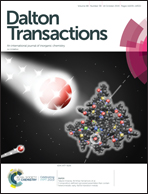Palladium complexes of N-heterocyclic carbenes displaying an unsymmetrical N-alkylfluorenyl/N′-aryl substitution pattern and their behaviour in Suzuki–Miyaura cross coupling†
Abstract
A series of new Pd–PEPPSI complexes containing imidazolylidene ligands with a mixed 9-alkyl-9-fluorenyl/aryl N,N′-substitution pattern have been synthesised. Single crystal X-ray diffraction studies were carried out for four complexes, which revealed that the N-heterocyclic carbene ligands display a semi-open, unsymmetrical space occupancy about the metal. Despite their particular unsymmetrical shape, the new complexes were found to perform as well in Suzuki–Miyaura cross coupling (dioxane, 80 °C) as previously reported, highly active analogues bearing two sterically protecting 9-alkylfluorenyl substituents. They were further found to be considerably more active than the standard Pd–PEPPSI complexes [PdCl2IMes(pyridine)] and [PdCl2IPr(pyridine)]. Surprisingly, unlike the latter, the unsymmetrical complexes of this study were practically inactive in isopropanol at 80 °C. Under these conditions the complexes appear to decompose with formation of non-stabilised nanoparticles.



 Please wait while we load your content...
Please wait while we load your content...